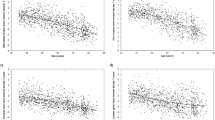Abstract:
Alendronate significantly increases bone mass and reduces hip and spine fractures in postmenopausal women. To determine whether forearm densitometry could be used to monitor the efficacy of alendronate, we examined changes in bone mineral density (BMD) at the forearm (one-third distal, mid-distal, ultradistal radius) versus changes at the hip (femoral neck, total hip) and spine (posteroanterior and lateral) in a double-masked, randomized, placebo-controlled clinical trial of 120 elderly women (mean age 70 ± 4 years) treated with alendronate for 2.5 years. We found that among women in the treatment group, BMD increased by 4.0–12.2% at the hip and spine sites (all p<0.001), whereas BMD increased only nominally at the one-third distal radius (1.3%, p<0.001) and mid-radius (0.8%, p<0.05), and remained stable at the ultradistal radius. At baseline, forearm BMD correlated with that of the hip (r= 0.55–0.64, p<0.001), femoral neck (r= 0.54–0.61, p<0.001) and posteroanterior spine (r= 0.56–0.63, p<0.001). Changes in radial BMD after 1 year of therapy were not correlated with changes in hip and spine BMD after 2.5 years of therapy. In contrast, short-term changes in total hip and spine BMD were generally positively associated with long-term changes in total hip, femoral neck and spine BMD (r= 0.30–0.71, p<0.05). Furthermore, long-term BMD changes at the forearm did not correlate with long-term hip and spine BMD changes, in contrast to the moderate correlations seen between spine and hip BMD at 2.5 years (r= 0.38–0.45, p<0.01). We conclude that neither short- nor long-term changes in forearm BMD predict long-term changes in overall BMD for elderly women on alendronate therapy, suggesting that measurements of clinically relevant central sites (hip and spine) are necessary to assess therapeutic efficacy.
Similar content being viewed by others
Author information
Authors and Affiliations
Additional information
Received: 18 February 1999 / Accepted: 20 May 1999
Rights and permissions
About this article
Cite this article
Bouxsein, M., Parker, R. & Greenspan, S. Forearm Bone Mineral Densitometry Cannot be Used to Monitor Response to Alendronate Therapy in Postmenopausal Women. Osteoporos Int 10, 505–509 (1999). https://doi.org/10.1007/s001980050261
Issue Date:
DOI: https://doi.org/10.1007/s001980050261




